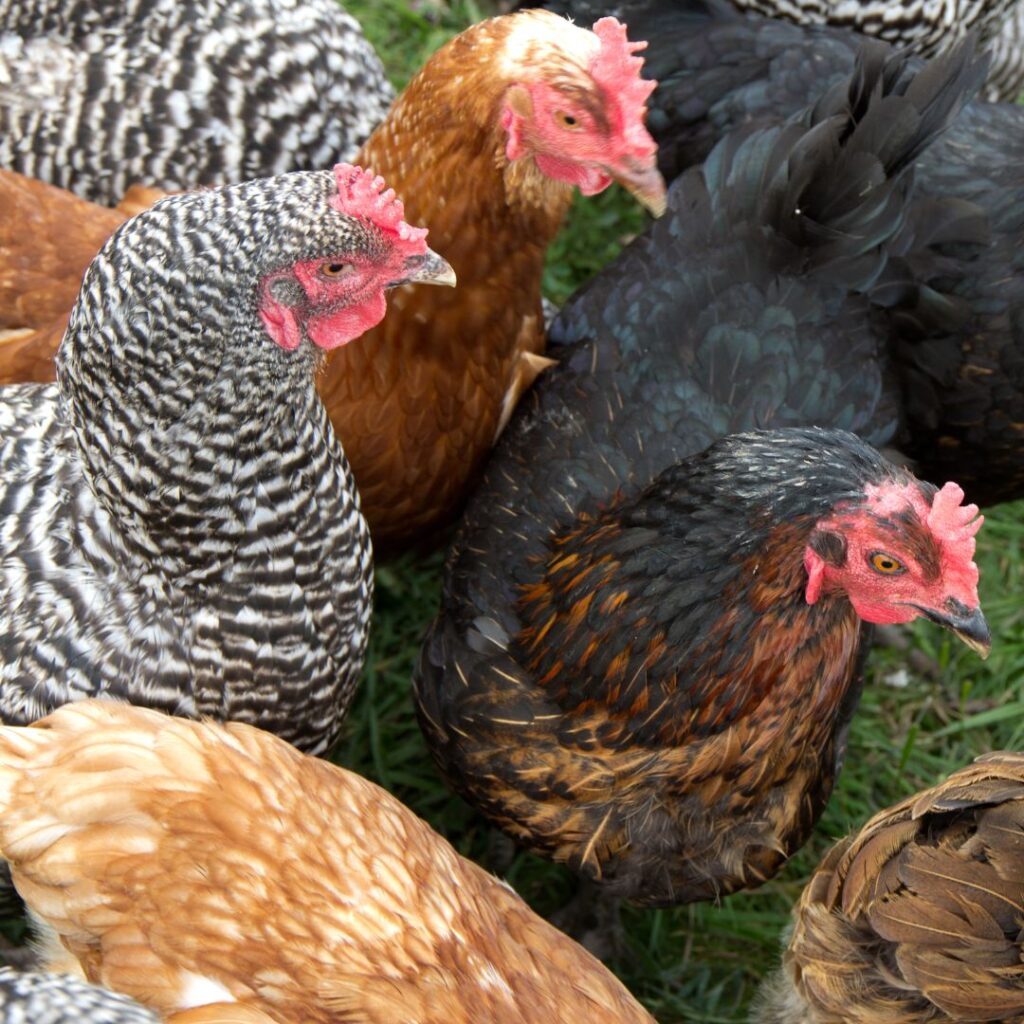Have you ever wondered, “What do roosters eat?” Understanding these beautiful birds’ dietary needs is essential for raising a backyard flock. This comprehensive guide will delve into the various feeds and supplemental foods for roosters, the foods to avoid, and the water requirements for these fascinating creatures.
Short Summary
- Roosters should be fed a combination of starter, grower, and layer feeds to meet their nutritional needs.
- Supplemental foods such as fruits, vegetables, grains, nuts, and seeds can also be added in moderation for extra nutrients.
- A clean water source is essential, with an appropriate feeding schedule adjusted based on breed age and activity level.
Rooster Feeding Basics
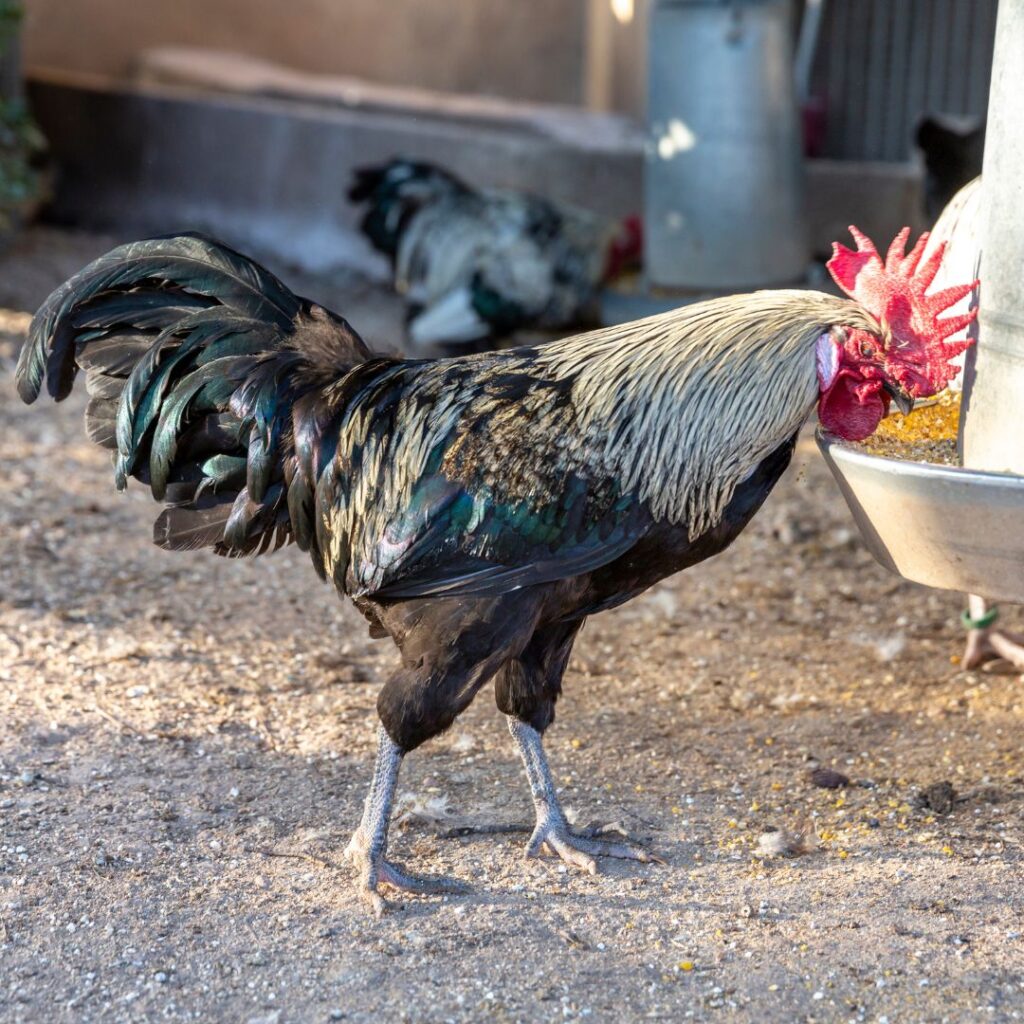
Like all poultry, roosters have specific nutritional requirements that change as they grow and mature. A well-rounded diet is crucial for maintaining their health and well-being. To ensure they receive the right nutrients at each stage of their lives, roosters should be fed a combination of starter, grower, and layer feeds.
Layer feeds, in particular, are designed for laying hens and contain higher calcium levels to support eggshell production. While roosters don’t require this extra calcium, they can still eat layer feed, but it’s essential to monitor their diet and make any necessary adjustments to avoid potential health issues when eating layer feed.
Let’s explore these different feeds in more detail.
Starter Feed
Starter feed is specially formulated to meet the dietary needs of baby chicks, with a protein concentration ranging from 20% to 24%. This high protein content is essential for their growth and development, ultimately contributing to their future egg production in hens. Starter feed should be given to chicks from the first day up to the eighteenth week, making it an essential component for any chicken keeper.
After the eighteenth week, chicks should be transitioned to grower feed, designed for young chickens not yet mature enough to lay eggs. This transition ensures they continue receiving the necessary nutrients for their ongoing development in your backyard flock.
Grower Feed
Grower feed is formulated specifically for young chickens not yet mature enough to lay eggs. It contains less protein than chick starter but still more than adult feed, making it necessary to feed roosters separately from laying hens. The protein content of grower feed ranges from 13% to 18%, vital for keeping young roosters healthy and supporting their growth.
Providing the right amount of grower feed for your roosters is important, especially if they’re being raised for breeding purposes. Restricting their grower feed intake can help ensure they receive the right balance of nutrients during this crucial stage of their development.
Layer Feed
Layer feed is intended for the majority of a rooster’s life, as it contains higher levels of calcium and protein than regular chicken feed. This increased calcium content is essential for laying hens to produce strong eggshells. However, roosters eat layer feed as well, which is not always necessary for them. To avoid potential health problems, it’s crucial to monitor the diet of your roosters and make adjustments if needed, such as providing supplemental feed like fruits and vegetables for a balanced diet.
While layer feed is an essential component of a rooster’s diet, it’s also vital to exercise caution when providing certain foods high in fat, such as sunflower seeds. These can lead to health issues if consumed in large quantities. By keeping these precautions in mind, you can ensure that your roosters and laying hens receive the nutrients they need to thrive.
Supplemental Foods for Roosters
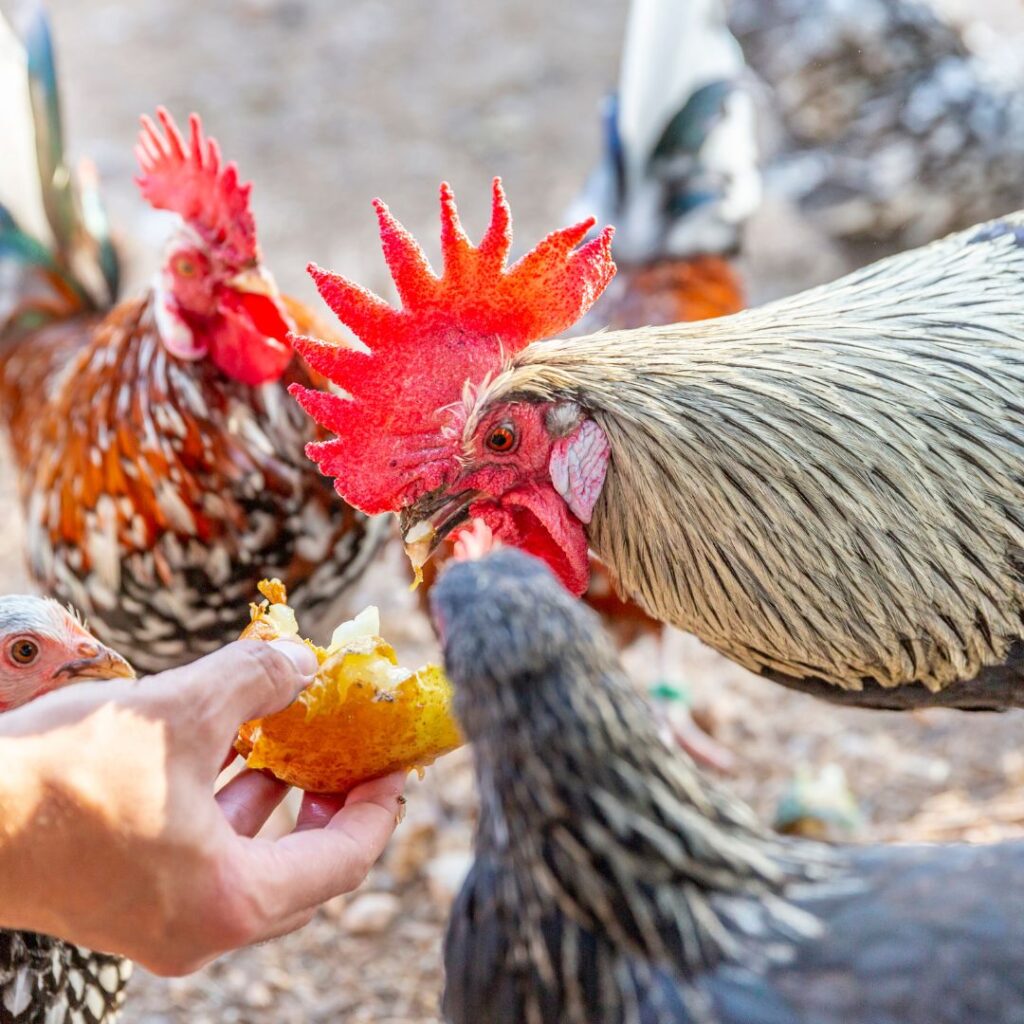
In addition to the various feeds, roosters can also benefit from various supplemental foods like fruits, vegetables, grains, nuts, and seeds. These food items provide additional nutrients and variety to their diet, keeping them interested and satisfied. Examples of such supplemental foods include tomatoes, apples, bananas, grapes, guava, berries, plums, peaches, lettuce, kale, spinach, cabbage, turnips, potatoes, carrots, and pumpkins, as well as sunflower seeds, corn, oats, and peas.
Remember, though, that moderation is key – providing a balanced diet and avoiding overfeeding is essential.
Fruits and Vegetables
Fruits and vegetables can be an healthy addition to a rooster’s diet, providing essential nutrients and a burst of flavor. Some suitable fruits for roosters include tomatoes, apples, bananas, grapes, guavas, berries, plums, and peaches. When it comes to vegetables, roosters can enjoy lettuce, kale, spinach, cabbage, turnips, potatoes, carrots, and pumpkins.
However, not all plants are safe for roosters. For example, uncooked beans can be toxic to birds, and roosters should avoid consuming them. Always research the safety of any new food items before introducing them to your rooster’s diet.
Grains, Nuts, and Seeds
Grains, nuts, and seeds can also be a valuable component of a rooster’s diet, providing essential nutrients and energy. Suitable options include sunflower seeds, oats, lentils, corn, millet, wheat, peanuts, walnuts, almonds, sesame seeds, cracked corn, chicken scratch, mealworms, raisins, barley, and hickory nuts in small quantities.
When offering pumpkin seeds to your roosters, avoid those with added sugar or seasoning coatings, as these can harm your birds. As with any food item, always practice moderation when providing grains, nuts, and seeds to ensure a balanced and healthy diet.
Insects and Small Animals
Being natural omnivores, roosters can consume a wide range of insects and small animals, which provide them with valuable protein and nutrients. Examples of insects suitable for roosters include butterflies, flies, crickets, blackflies, caterpillars, earwigs, coddling moths, grasshoppers, ticks, millipedes, aphids, spiders, and termites.
In addition to insects, roosters eat small animals such as worms, rats, mice, lizards, snakes, and frogs. However, ensuring these small animals are safe for consumption and free from any potential diseases or parasites that could harm your birds is essential.
Foods to Avoid for Roosters’
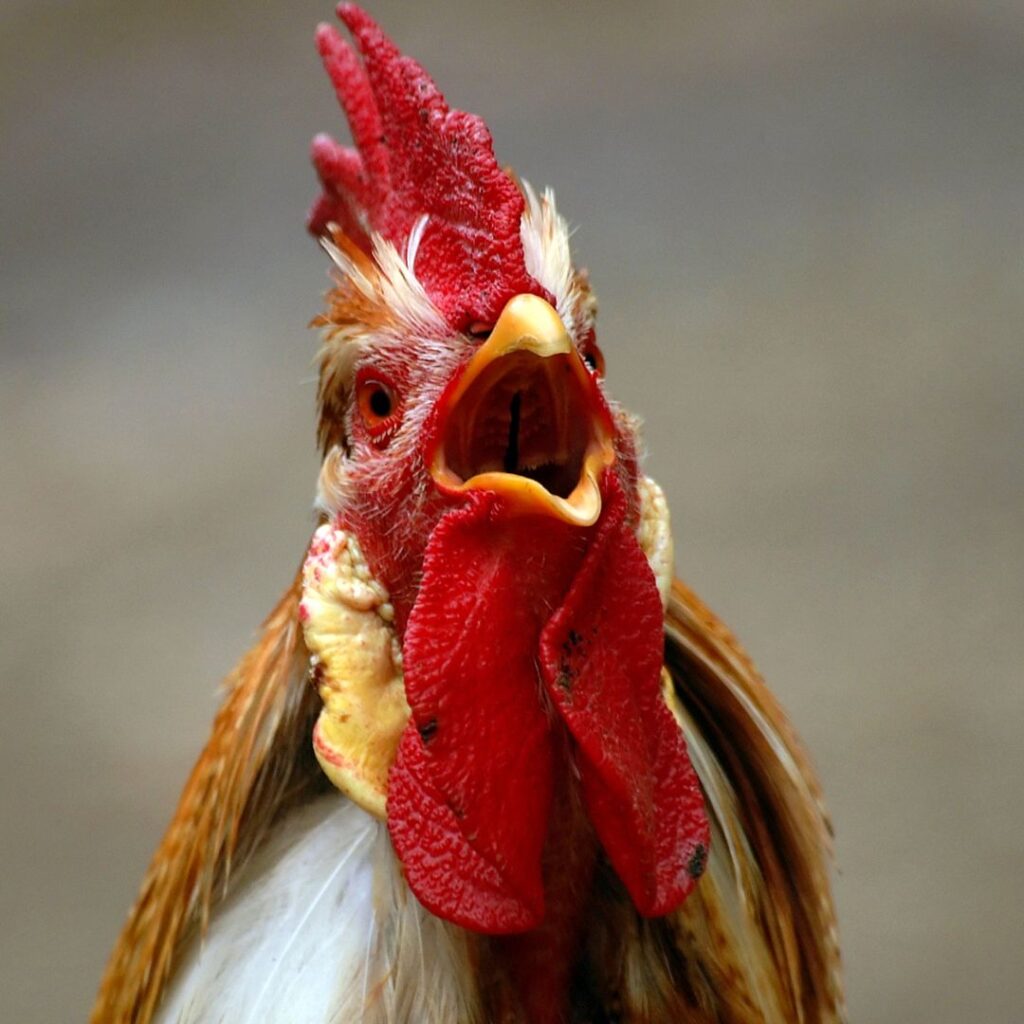
While roosters can enjoy a wide variety of foods, some items should be avoided for their health and well-being. Foods like chocolate, caffeine, moldy food, cooked tomatoes, potatoes, rhubarb, avocados, dairy, and onions are not suitable for roosters and can pose risks if consumed.
Cooked tomatoes, potatoes, and rhubarb contain oxalic acid, which can be toxic to roosters. Therefore, these foods should not be part of their diet. Ingestion of such foods can cause kidney damage in birds and lead to softer eggshells in hens.
Always be cautious when introducing new foods to your roosters, and research any potential risks before offering them to your flock.
Water Requirements for Roosters
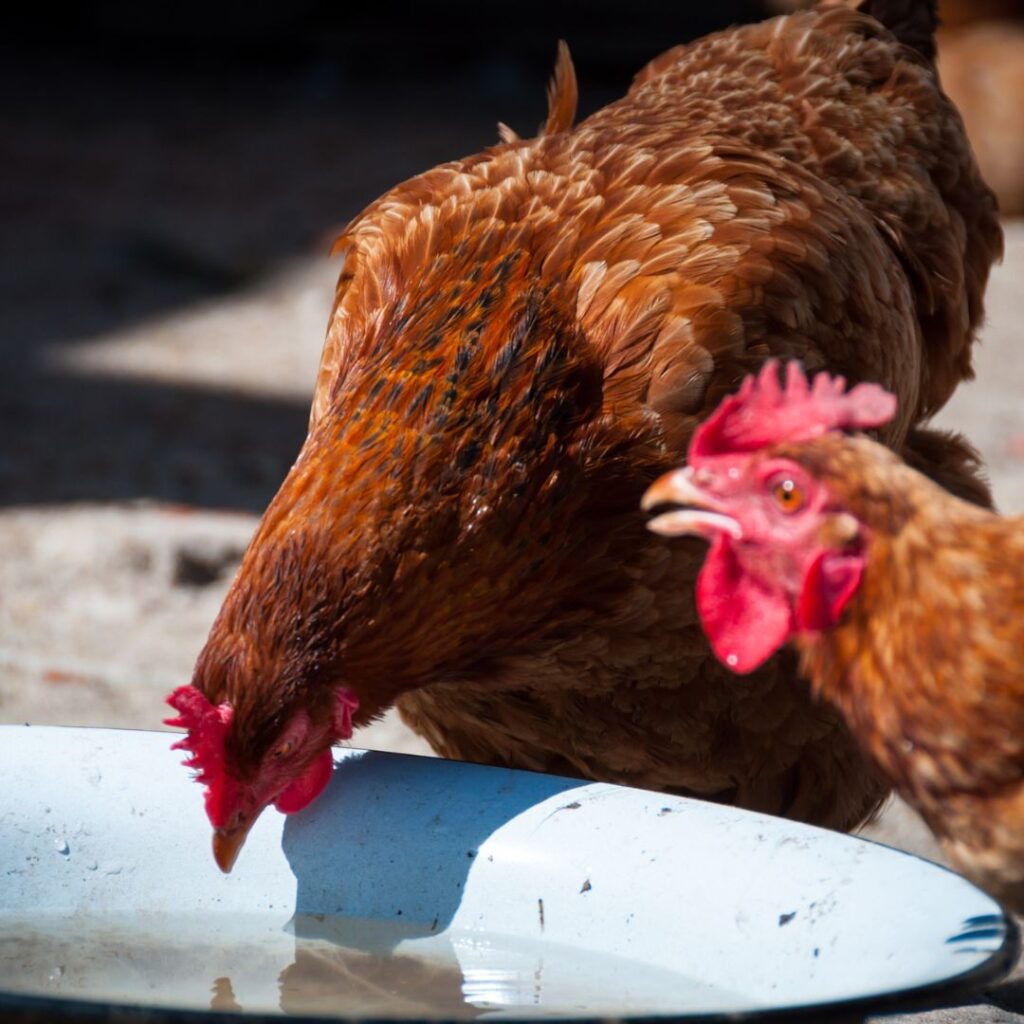
Like all living creatures, roosters require constant access to fresh, clean water to remain hydrated and healthy. Water is particularly crucial during hot weather, as it helps roosters cool themselves and avoid dehydration, which can be fatal. An adult rooster should consume approximately 400 ml of water daily.
To maintain the cleanliness of your roosters’ water supply, always clean waterers with soap before refilling to inhibit bacterial growth. Providing fresh water is a simple yet vital aspect of keeping your roosters healthy and happy.
Feeding Schedule and Tips
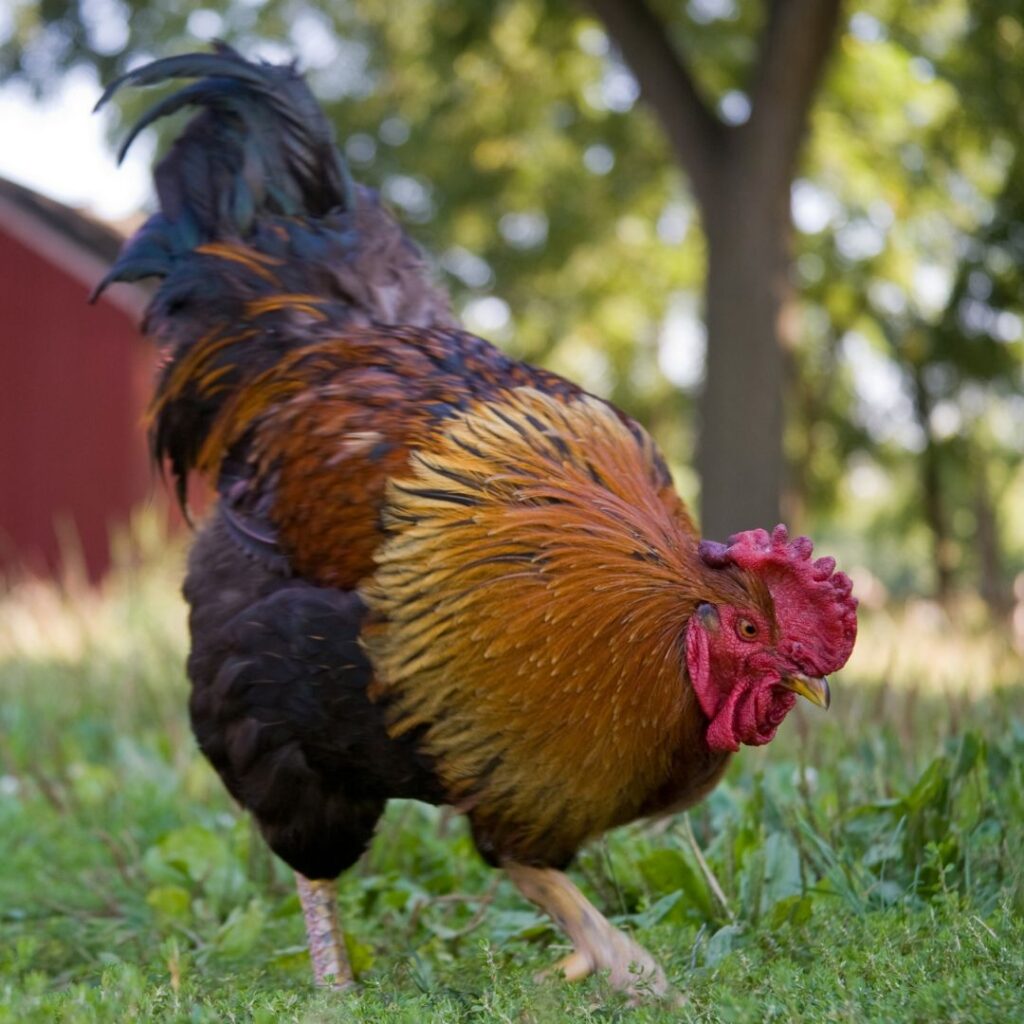
There are no strict rules when it comes to feeding schedules for roosters, as their nutritional needs can vary depending on factors such as breed, age, and activity level. However, it’s essential to follow the instructions on the chicken feed packaging and monitor your roosters’ eating habits to ensure they consume an appropriate and balanced diet.
Some chicken keepers prefer to feed their roosters twice a day, while others use feeders that allow the birds to eat as needed. Treats should be offered sparingly to avoid overfeeding and maintain a healthy diet.
By observing your roosters and adjusting their feeding schedule as needed, you can ensure they receive the proper nutrition to thrive.
Related: Beginner Chicken Owner Tips
Rooster Breeds and Specific Diets

Different rooster breeds have specific temperaments and protein requirements, which can impact their dietary needs. Purina Animal Nutrition recommends a separate diet of Purina Flock Raiser for roosters, as it contains the right balance of nutrients to support their health. Flock Raiser is an ideal diet for adult birds. Lay hens can be supplemented with Purina oyster shells to meet additional calcium needs.
Paying attention to the specific dietary requirements of your rooster breed can help ensure they receive the nutrients they need for optimal health and well-being. By providing the appropriate feed and supplemental foods, you can support the health of your entire backyard flock.
Raising Roosters with Laying Hens
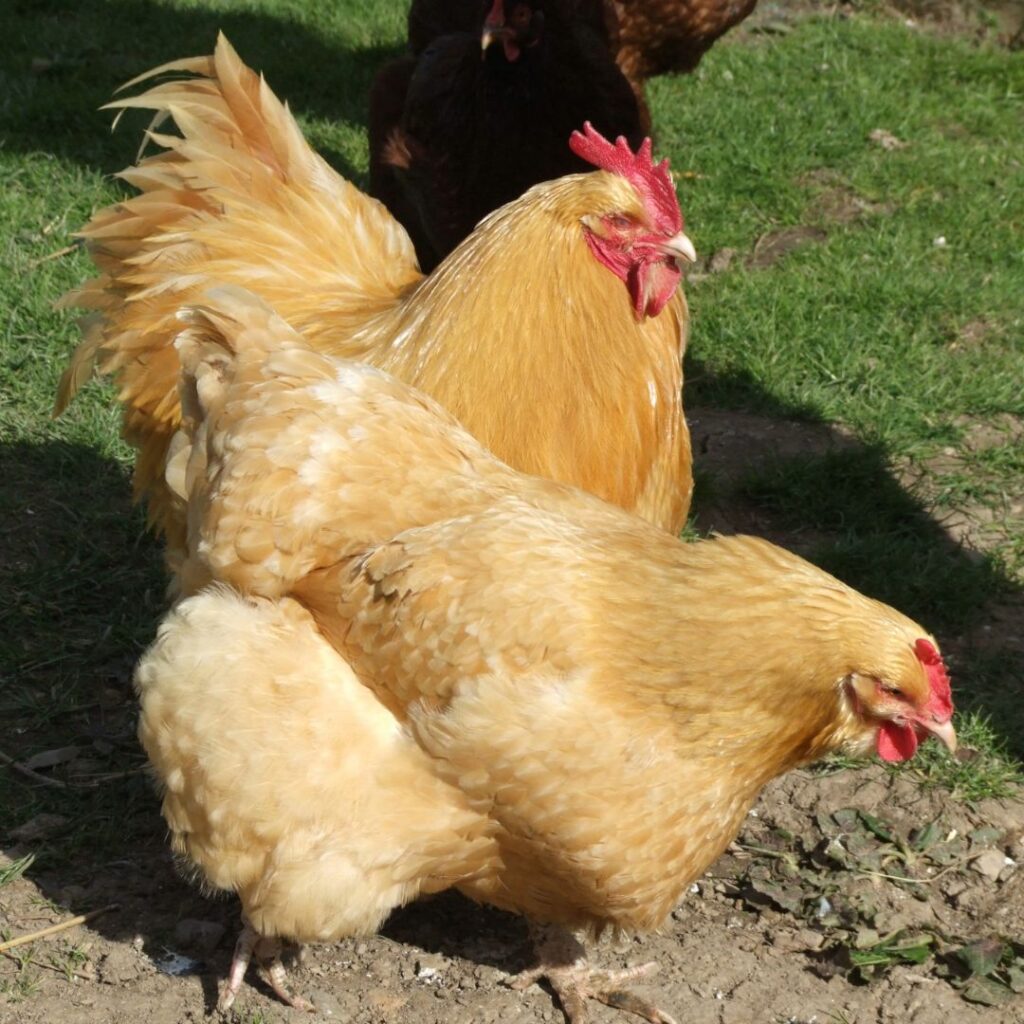
Raising roosters alongside laying hens offers several benefits, such as protecting the hens and the presence of fertilized eggs, which allows you to potentially hatch your own chicks. However, some people prefer to keep their rooster separately for various reasons, as roosters tend to be more aggressive and territorial.
However, it’s essential to ensure that roosters do not consume layer feed intended for laying hens, as it contains higher levels of calcium that may not be suitable for roosters. To prevent roosters from eating the hens’ feed, separate them during feeding time or provide a separate pen for feeding. Taking these precautions ensures that your roosters and laying hens receive the proper nutrition they need to thrive.
Summary
In conclusion, understanding the dietary needs of roosters is crucial for backyard flock owners who want to ensure the well-being and health of their birds. By providing the appropriate feeds and supplemental foods, monitoring their eating habits, and taking precautions when raising roosters with laying hens, you can create a thriving backyard flock that will bring joy and satisfaction for years.
Frequently Asked Questions
What should I feed my roosters?
To ensure the health and vitality of your roosters, we recommend feeding them a separate diet from laying hens with Purina Flock Raiser® as the main component. This high-protein feed will help keep your roosters strong and healthy.
For best results, you can either raise one of the feeders so only the roosters can reach it or feed your roosters in a separate pen.
What foods can Roosters not eat?
Roosters should not be fed avocados, chocolate or candy, citrus fruits, green potato skins, dry beans, junk food, moldy or rotten food, and items with high salt content.
It is also important to avoid giving roosters food scraps containing anything high in fat or salt and any food that has gone bad.
What is a Roosters’ favorite treat?
A rooster’s favorite treat is fruit, such as bananas, apples, and berries. These treats should be fed in moderation, as too much can cause loose stools.
Herbs such as lavender, oregano, parsley, and basil are also popular snacks among chickens.
They’re also known to forage upon pesky weeds, ticks, grubs in your yard. For a boost of protein, you can serve them some mealworms.
What are Roosters’ favorite foods?
Roosters enjoy a variety of foods, including commercial feed, scraps from the dinner table, grains, fruits, and vegetables. They especially like corn, cooked rice, cheese, and noodles.
Leafy greens such as lettuce, kale, and other greens are also popular treats for roosters.
What should I feed my rooster at different stages of its life?
For best health and growth, it is important to ensure that your rooster receives the appropriate feed as it develops from a chick into adulthood. Starter feed should be given during the first stage of its life, grower feed when it reaches juvenile stages, and layer feed once it is mature.
Dietary requirements may vary, so adjust feed accordingly.



